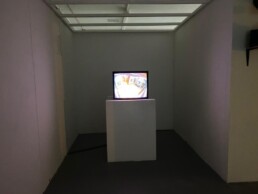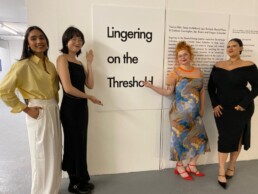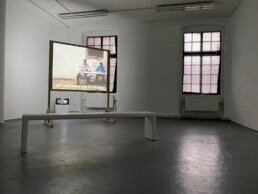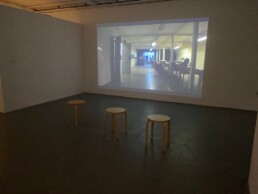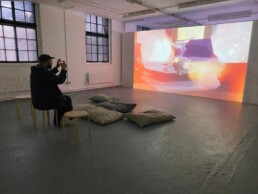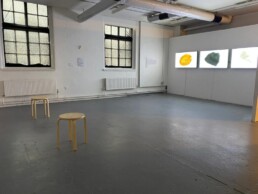Francis Alÿs, Sanja Anđelković, Igor Bošnjak, Rachel Pimm & Graham
Cunnington, Ben Rivers, Gregor Schneider
An exhibition curated by MA Curating & Collections students featuring work from The Artangel Collection and The October Salon Collection.
Private View, Monday July 1st, 6pm – 9 pm
Open July 2nd through July 5th from 12-8pm and July 6th from 10am – 4:30pm.
Chelsea College of Arts, 16 John Islip St. SW1P 4JU
Block A: Rooms AG02, AG03, AG04, & AG05
Lingering on the Threshold brings together works from The Artangel collection and The October Salon collection. In these works, liminality functions as a way for artists to to engage with cultural, economic, and environmental concerns by searching for new solutions outside of their current structures. In an increasingly saturated digital world, we find ourselves drawn to the realms of phantasmagoria and liminality as an escape from the noise and density of waking reality. The term “liminal” comes from the Latin word “limen,” meaning threshold. Within the exhibition, these in- between spaces take the form of desolate nuclear bunkers, museum galleries after hours, and the backseat of a taxi. Through the sphere of liminality, we discover a terrain unbound by societal expectations and prescriptions. Liminality is state or space characterised by transformation. It is here, in this ephemeral and often enigmatic state, that our minds are liberated, allowing us to explore the depths of our existence. Lingering on the Threshold functions as a labyrinth of stories in which we
invite visitors to get lost and come in contact with a dreamscape of memory, suggestion, and wonder.
Francis Alÿs’ The Nightwatch (2004) tracks a rogue fox navigating the maze of London’s National Portrait Gallery at night, seen through their CCTV system. The fox re-examines many of the same rooms, searching for entrances and exits amid a whirlwind of London’s historical ghosts. Similarly, Gregor Schenider’s Die Familie Schneider (2004) maps identical neighbouring houses, 14 and 16 Walden Street. Filmed from the perspective of the visitor and screened side-by-side, the films provide an experience of moving through the houses: faded yellow wallpaper, stained carpets, dark basements, and uncanny encounters with identical twins. Igor Bošnjak’s Hotel Balkan (2013) walks us through a desolate nuclear bunker in Bosnia, its architecture haunted by its mortal conception and the uncanny nature of human absence. Navigating through dark corridors and surrounded by textural audio reminiscent of a Geiger counter, Hotel Balkan is a liminal encounter with space and memories of the past. Ben Rivers’ Mrabet and Taxi are selections from his suite of five films, The Two Eyes Are Not Brothers (2015), partially based on Paul Bowles’ 1947 novel, A Distant Episode. In Mrabet, Rivers documents his encounter with Mohammed Mrabet, a storyteller and artist, now 88, who recounts myths and memories, blending documentary, fantasy, and fable. In Taxi, the audience is met with the haunting gaze of a fellow passenger, with directions to and from remaining unsaid and unknown, focusing instead on the interpersonal probing of sharing transitory space. This exploration of memory and liminality extends to Francis Alÿs’ Fitzroy Square (Railings) (2005), where architecture becomes a reverberating musical instrument, echoing a
sensorial memory in the city’s bones. Similarly, Sanja Anđelković’s Look up! I am no canopy- I am a messenger (2022) is a multidimensional audio/visual portal with psychological sentimentality. Guided through the animated dreamscape by an ethereal choir providing prophecies about our time, the orthodox songs lead to abstract thoughts on social issues like climate change and eco-feminism. Rachel Pimm and Graham Cunnington’s an earshare / to cassay the earthcrust (2021) is a site-specific investigation of the violent historical traces found at Orford Ness. This exploration between conservation, geology, and quantum mechanics, is centred around the concept of “earsharing,” the act of deeply listening to the Earth’s natural qualities.
Lingering on the Threshold is curated by Nis Amzee Murat, Yining Bai, Stephanie Colclough, Mengze Geng, Riccardo Greco, Maria Herrero Tejada, Yaqi Liang, Heyue Lu, Wenyan Ma, Aayushi Rajput, Qinxue Shen, Mahalia Sobers, Charmaine Wah, Wanjing Lin, Xingcheng Xu, and Lilian Zancajo-Lugo
Artist Biographies:
Francis Alÿs (1959, Antwerp, Belgium) lives and works in Mexico City. His artistic practice spans video, painting, performance, and drawing, often focusing on poetic and political interventions in urban spaces. Alÿs has participated in significant exhibitions, including the Venice Biennale (2001, 2007, 2017, 2022) and the Tate Modern, London (2010). His work addresses themes such as migration, community, and geopolitical conflict, and his interest is reflected in the social and political dynamics within urban environments.
Sanja Anđelković (1991, Novi Sad, Serbia) is an audio-visual and textual researcher-artist. Dedicated to the field of played/speculative practice, where she reconsiders her own position within the system of gender, socio-political roles and/or traumatic moments in personal history, and examines the way in which the idea of ‘home’ is changed in the historical, geographical, or environmental context. She received the New Seed Award from the Prince Claus Fund from Amsterdam (Holland, 2021). Her work has been shown at “Fabulation for Future” – Film University Babelsberg Konrad Wolf, Potsdam (Germany) at the exhibition entitled “How to be a Posthuman”. She has cooperated with anthropologist Hsiu-ju Stacy Lo on a speculative CGI feature film.
Igor Bošnjak (1981, Sarajevo, Yugoslavia) lives and works in Trebinje (Bosnia & Herzegovina) as an visual artist and filmmaker. He works on interdisciplinary research, addressing history, migrations and image-time relations as key reference in the experience of contemporary society. He is mainly working within the media fields of contemporary art: moving images, video, film, 3d animation, installation and photography. From 2006 to 2016 he was founder and curator of namaTREba project biennial. More information can be found on namatreba-project-biennial.blogspot.com. From 2009 works as a professor at Academy of Visual Arts in Trebinje, University of East Sarajevo on courses of Video, Intermedia art, Digital art. From 2019 to 2020 he was working as a visiting lecturer at the Faculty of Fine Arts Cetinje, University of Montenegro.
Graham Cunnington (1960, London, UK) lives and works in London, UK. Cunnington is primarily known as a musician and performer, also a key member of the influential industrial music group Test Dept. His work spans music, performance art, and multimedia projects. Cunnington’s performances are characterised by political intensity and social commentary, often addressing themes like resistance, labour, and industrial decline. Notable projects include collaborative performances with miners during the UK miners’; strike and large-scale industrial soundscapes, reflecting his commitment to exploring power dynamics and struggles of working-class communities; and the autobiographical solo performance ‘Pain’.
Rachel Pimm (1984, Harare, Zimbabwe) lives and works in London, UK. Pimm’s multidisciplinary practice includes performance, video, and installation, often focusing on ecological themes and the materiality of the natural world. Their work has been exhibited at institutions like the Whitechapel Gallery, London, and the Serpentine Galleries, London. Pimm’s projects often address the intersections of biology, geology, and environmental politics, emphasising the interconnection with ecosystems and the impact of human activity on the environment.
Ben Rivers (1972, Somerset, UK) lives and works in London, UK. Rivers is a filmmaker known for his experimental approach to documentary and narrative forms. His work often blurs the lines between fiction and reality, capturing remote and isolated landscapes. Rivers has exhibited at prestigious venues such as the Venice Film Festival, Locarno Film Festival, and Tate Britain. His films frequently explore themes of isolation, survival, and human interaction with nature, reflecting his fascination with the boundaries between the known and the unknown.
Gregor Schneider (1969, Rheydt, Germany) lives and works in Mönchengladbach-Rheydt. Schneider builds complete rooms consisting of floors, walls and ceilings in existing rooms. These rooms can be completely transformed into everyday life. Visitors are reminded of his disturbing depictions of living spaces to create existential confrontations. His remarkable project “Haus ur” includes the reconstruction of his parents’ house in Rheydt (1985-present). For this work he received the Golden Lion at the Venice Biennale in 2001. Schneider’s built rooms often deal with themes of fear, identity, the uncanny and question the perception of familiarity.
About the Exhibition Partners:
MA Curating and Collections at Chelsea College of Arts is a fifteen month programme centred on working in partnership with organisations across the contemporary art landscape and alongside established curators. This hands-on course equips students to handle art and design objects, learning directly from professionals across the sector. We are committed to developing ethical curatorial practices. To achieve this, we are working to embed UAL’s Principles for Climate, Social and Racial Justice into the course. arts.ac.uk/subjects/curation-and-culture/postgraduate/ma-curating-and- collections-chelsea
Artangel produces and presents extraordinary art in unexpected places in the UK, and beyond. Appearing anywhere from empty prisons to underground vaults, daytime TV to the sky at night, Artangel produces art that takes on many different forms and appears in many different places. The Nightwatch, Fitzroy Square (Railings), Die Familie Schneider, an earshare / to cassay the earthcrust, Mrabet, and Taxi, are part of The Artangel Collection, an initiative to bring outstanding film and video works, commissioned and produced by Artangel, to galleries and museums across the UK. The Artangel Collection has been developed in partnership with Tate, is generously supported by the Esmée Fairbairn Foundation and The Foyle Foundation, and uses public funding from Arts Council England. You can explore the collection further on artangel.org.uk.
The October Salon is the biggest international contemporary art manifestation in Serbia, established by the City of Belgrade in 1960. The Salon opens its doors every other year on the 20th of October in honour of Belgrade’s Liberation Day during the Second World War. The collection comprises approximately 200 works by more than 100 artists and groups.oktobarskisalon.org
A special thank you to Frank Brown, Persilia Caton, Marina Doritis, Zorana Đaković Minniti, Adriano Digaudio, Lina Dz̆ uverović, Patricia Ellis, Matthew Evans, Ben Fitton, Karen Di Franco, Sam Hewland, Ian Monroe, Lucy Reynolds, Lynton Talbot, and Lenny Terrones-Huet
Press Contact: Lina Dz̆ uverović // l.dzuverovic@arts.ac.uk



